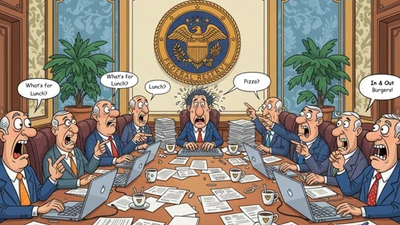Today’s the day the Federal Reserve drops the minutes from its latest meeting — the bureaucratic equivalent of releasing a new season of a show nobody asked for, but everyone watches anyway because it still moves the markets. At 2 p.m., the Fed will tell us what they were really thinking behind those tight-lipped press conferences and polished statements.
For Republican-leaning investors who prefer their markets stable, their debt ceilings lifted, and their regulators predictable, this release matters more than a Friday jobs report with too many decimals.
So what’s on deck today?
The Big Reveal: A Divided Fed
The preview from analysts suggests the Fed is split — and not the fun kind of “split,” like a 2-for-1 stock. More like “two board members think we should cut rates, and two think a hawk should run monetary policy.” The minutes will likely show a deepening divide over inflation risks versus growth risks.
In other words: even the people steering the economic ship can’t agree whether they should speed up or hit the brakes. Comforting, isn’t it?
Why It Matters for Investors Today
Rate expectations are the undercurrent driving everything from mortgage rates to your favorite dividend stock. The Fed isn’t expected to make any big moves today, but the language in the minutes — those carefully crafted paragraphs written in English-as-a-Second-Language-by-Committee — could shift expectations rapidly.
If they sound cautious, markets will assume rate cuts are farther away.
If they sound optimistic, markets will assume rate cuts are… less far away.
Either way, Wall Street will spin it into chaos, and retail investors will get a push notification explaining why their portfolio suddenly looks like someone shook it like an Etch A Sketch.
Watch for These Unique Data Points
Investors should watch the gems buried between the jargon — the details the media will gloss over while focusing on whether Powell’s hair looked confident this week.
Here’s what actually matters:
1. Housing and Construction Mentions
If the Fed so much as whispers about “slowing housing demand,” expect construction-linked sectors to wobble.
If they mention “housing resilience,” expect builders to smile and mortgage lenders to breathe again.
2. Inflation Contributors
The Fed often drops clues about what’s still causing inflation. If they name materials, labor, or construction inputs, that’s your signal that costs for builders and manufacturers could stay elevated.
3. Employment Cooling
If the minutes mention a “softening labor market,” markets will take that as code for “rate cuts incoming”—eventually.
4. Disagreement Inside the Fed
This is the real entertainment. If the report confirms a widening split, buckle up. Divided committees create choppy markets. Unified committees create predictable ones. And lately the Fed looks like it’s debating where to order dinner.
Bottom Line for Conservative Investors
Today isn’t about fireworks — it’s about tone, positioning, and what the Fed is really worried about. Republican investors should be watching for signals of:
- Whether borrowing costs will stay sticky
- Whether the housing market gets a nod of approval or a warning
- Whether inflation is being driven by core essentials or just noise
- Whether the Fed seems confident, confused, or both (the typical answer)
In short: today’s minutes won’t change the world, but they will tell you who at the Fed is carrying the flashlight and who’s still looking for the batteries.











